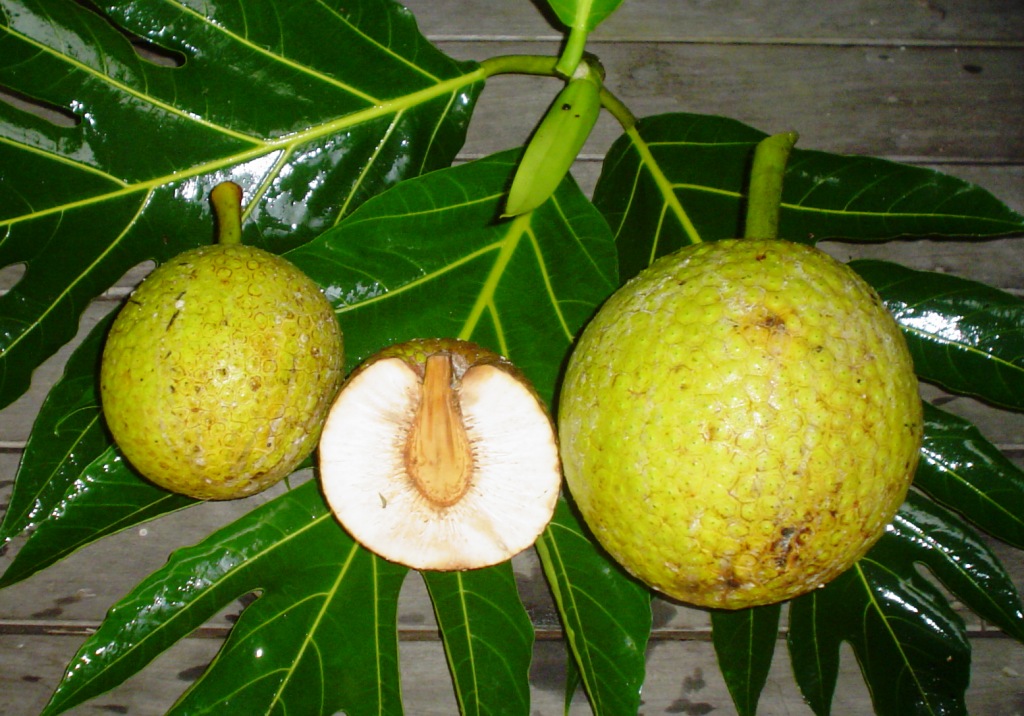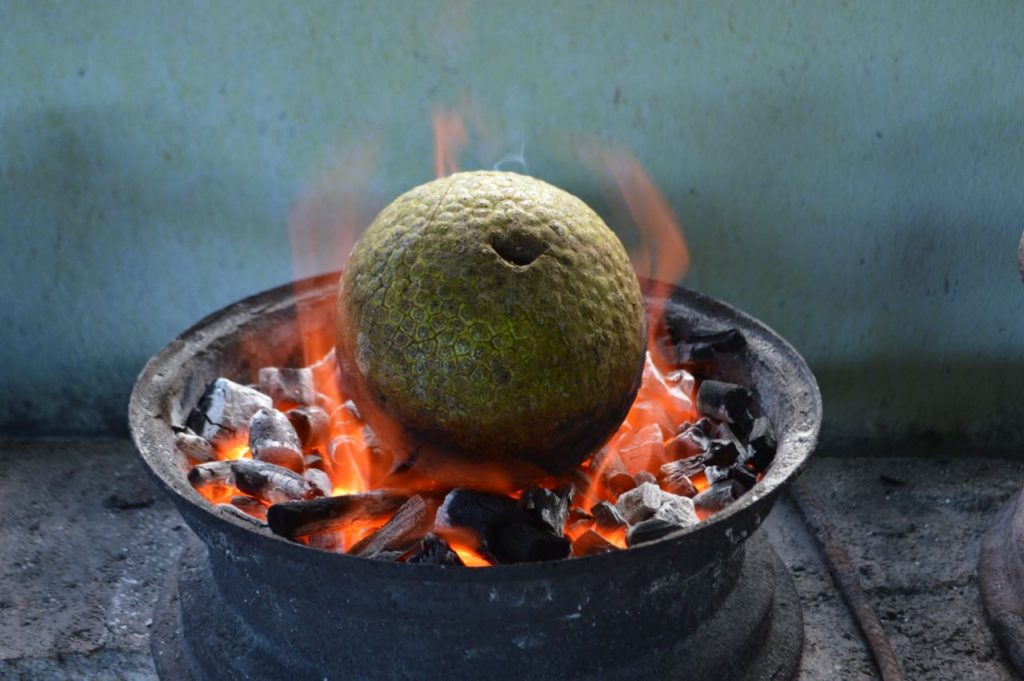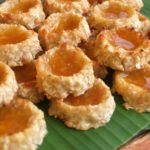Exotic Food Finds: The Breadfruit

Artocarpus Altilis, better known as breadfruit, has been an important crop and component throughout the Pacific, where indigenous people have relied on breadfruit as one of their main staples for many generations. The scientific or Latin name is derived from Greek (artos = bread, karpos = fruit), and altilis means ‘fat’. This unique and out-of- the-ordinary fruit has certainly tickled one’s mind; wondering where on earth it came from or what methods of cooking will be most suitable for revealing its immaculate flavors?
Its existence up until now has proven to be a very cheap and natural source that is able to substitute starches like pasta or potatoes and has been designated most recently, as a solution to help curb starvation in poor countries globally. Its versatility has allowed many to transform this fruit into salads, chips, casseroles, sweet treats and has even hit the gastronomical charts with larger companies brewing beers. Although it is a very cheap crop which does not require much maintenance, its health benefits is an added bonus to ensure the proper nutrition of those consuming it. Chefs alike have been transforming this starchy delight into satisfying dishes made palatable in the most unique ways. The breadfruit is no longer the food of the slave trade, but the upcoming salvation for dilapidated cultures and mal-nourished societies.
Superior Traits
Breadfruit trees produce abundantly and require minimal maintenance. Overlooking its characteristics, author July F. Morton of “Fruits of warm climates” confirms that in its green stage, the fruit is hard with a very starchy white interior. Whereas, when fully ripe, it’s yellowish interior is showcased with a slightly sweet fragrance and is softer in texture. The seeds can be found in the center of the fruit which is oval, rounded at one end, pointed at the other. The tree can grow up to eighty feet tall, producing hundreds of soccer ball shaped fruit year-round, with each weighing up to eight pounds. The fruit is picked when maturity is indicated on its skin, as one could see small droplets of latex on the outside of the breadfruit.

Historical Background
Although this plant caught the attention of voyaging islanders, author Hector Rodriguez, Latin Caribbean Food Expert explains in his article “About Breadfruit”, that it has been cultivated and consumed for more than three thousand years, originating from New Guinea. Whilst Pacific islands were settled by migrating Polynesians and Hawaiians, the fruit was said to be widely spread in 12th Century AD.In the 1500s, Europeans discovered this starchy prolific (fruit producing much fruit or foliage) plant and were very satisfied; realizing that when roasted resembled bread.
The fruit made its incredible debut during Colonization in the Caribbean, as Britain’s wealth lay in the sugar cane plantation, leaving no room to cultivate crops to feed the slaves. The success of their plantations depended on providing meals for the day-to-day labor of the slaves which mostly, was imported from North American colonies, but this all stopped because of the American Revolutionary War. The islands were minute, and planters needed a cheap source of food. Thus, in 1793 after multiple attempts authorized by King George III, William Bligh of the HMS Bounty (ship’s name) transported a total of 677 breadfruit plants from Tahiti to the Caribbean. Over the years, the fruit gradually spread to other tropical regions because of this successful voyage with varieties grown in over ninety countries.
A Healthy Selection

Amazingly, The National Tropical Botanical Garden in its article reveals breadfruit as a good source of fiber, calcium, copper, iron, magnesium, potassium, thiamine, and niacin. Some varieties are good sources of anti-oxidants and carotenoids. Like many other foods such as plantains or bananas, they may be eaten ripe as a fruit or under ripe as a vegetable. It is about one to three percent protein, which is less than rice and wheat, but comparable to potatoes and other starchy crops. The most popular way to prepare breadfruit today is to boil them whilst still starchy or roasted on coal or an underground oven, to be paired with hearty stews, meats, soups and beans.
Breadfruit is highly acclaimed to be a delicious substitute for any starchy root crop, vegetable, pasta, potato, or rice by the Global Breadfruit institute. Gluten-free flour can be derived from the fruit, proven to be more tasteful and is far more superior in structure over any other gluten flour on market shelves today. Storage is also quite simple; the fully cooked, frozen product could be used on a year-round basis, making it more practical for families and chefs.
History Repeats Itself
“The 21 st Century Savior”
The breadfruit is certainly a plant that has been respected for its ability to feed people in large masses during the periods of the slave trade and have continued to do so today as well. Breadfruit remains uncommon to certain parts of the world and is not yet commercialized mainly because it can only be grown in a specific climate; wet tropical areas. This weather has ironically been listed to be present in some of the world’s most food-deprived regions. Change is beginning to secure victory for the countries who have not yet experienced the great impact of the breadfruit, risen because of the concern of starvation; a topic of interest and controversy. Horticulturist Josh Schneider from San Diego began turning the wheel of time. “Every time we plant one of these trees; we’re reducing the susceptibility to famine and starvation in the country where the tree is going” (Schneider).
It has encouraged the formation of“Global Breadfruit” an organization Synder is a part of who has already been meeting with government officials to help develop countries that are starving with every hour of each passing day. Dr. Diane Ragone, director of the Breadfruit Institute confirms “For the first time in history, we have a potentially permanent solution to hunger in tropical regions.” Because unfamiliarity with breadfruit is a barrier, Hooulu ka Ulu Hawaii also holds festivals and workshops to raise public awareness.
Multipurpose
The Global Breadfruit institute has identified some magnificent aspects of how well this fruit can be used besides being a mouthful. The latex excreted from the breadfruit is commonly used as a waterproof caulking for water crafts and homes. The male breadfruit flower is highly effective at repelling mosquitoes and other insects. Animals have also acquired a taste for this fruit as its leaves from the tree and any fallen fruit are fed to livestock on farms or large-scale production (Global Breadfruit). Mosquito nets, clothing, accessories, artwork and even paper can all be developed from fibers harvested from the bark of the tree.
Phenomenal Food Trends
Who ever knew that breadfruit could be turned into full bodied and highly carbonated booze, blended irresistibly with tropical tones? Sam Calagione founder of Dogfish Head’s brewing company in Milton Delaware after reading about it become the mastermind of this flavor profile and directed his interests and ideas towards Hawaii’s Maui Brewing Company, developing “Liquid Breadfruit”. Together they have been distributing the starchy breadfruit with papaya seeds and calypso hops. Author Steve of The Barley Whine gives professional insight of this phenomenon of an unforgettably bold 8 percent alcohol infused experience; “The taste is a revelation! The sweetness from the nose is there with some complexity that comes with having fruit in a beer. The yeast and breadfruit pair deliciously, making this taste a bit like a Belgian blonde, with layers of flavor delivered briskly by the strong carbonation. Such a refreshing brew you can’t stop sipping. Could be a beautifully tempting choice on a hot summer day as the higher alcohol would never be detected until too late. Ravishingly delicious.”
Even though distribution has been limited to a few western states and the island Draft Magazine has taken notice of this remarkable drink and has selected Liquid Breadfruit to be amongst the top twenty-five for 2012. Besides beer, many islanders take pride by submitting home-made recipes in competitions to raise awareness and passion for using breadfruit. A crowd favorite, the Pūnana Cookie submitted by Raven Hanna and Jeremy Lutes at Puna Ulu Festival recipe contest 2012, stole the spot light of Best of Show award held by the National Tropical Botanical Garden.
Pūnana Cookies

Pūnana Cookies
Ingredients
- 1-1/2 cups Ripe ulu (breadfruit) steamed
- 1 cup Unsalted macadamia nuts finely chopped raw
- 1/2 cup Unsweetened coconut dried
- pinch Sea salt
- 1/2 tsp Cardamom
- Ginger jelly
- Macadamia nut oil for pan (optional)
Instructions
-
Preheat oven to 350 degrees F. Mash steamed breadfruit using a crank processor, a potato masher or a brief pulse in a blender. The resulting paste should be sticky and clumpy, like buttermilk frosting.
-
Put the macadamia nuts, coconut, salt and cardamom in a mixing bowl and fold in the breadfruit paste, much like mixing butter into a batter until all the ingredients are well incorporated.
-
Either wipe a cookie sheet with macadamia oil or use a non-stick cookie sheet. Take about one tablespoons of breadfruit batter and roll into a ball. Form the dough into a nest with an impression on top for the jelly. Wet hands can help form the well-structured nest. Fill the sheet with the nests about 1 to 2 inches from each other. Then add about 1/2 a teaspoon of jelly to each nest.
-
Put the cookie sheet into the oven and bake at 350 degrees F for about 20 minutes, or until the cookies are lightly browned on the bottom and/or top. Remove and cool on a rack. Enjoy!
Recipe Notes
This recipe is easy, healthy (for a dessert). Also, it is vegan and gluten free!
References:
Herreria, Carla. “Breadfruit: The Next Superfood To End World Hunger?” The Huffington Post.
N.p., 14 Nov. 2013. Web. 13 Oct. 2014.
<http://www.huffingtonpost.com/2013/11/14/breadfruit-world- hunger_n_4271436.html>.
“History of Breadfruit.” National Tropical Botanical Garden. N.p., n.d. Web. 22 Sept. 2014.
<http://ntbg.org/breadfruit/breadfruit/history1.php>.
Morton, Julia F. “Breadfruit: Artocarpus Altilis.” Breadfruit. N.p., 24 Sept. 2013. Web. 22 Sept.2014.
<http://www.hort.purdue.edu/newcrop/morton/breadfruit.html#Culture>.
Rodriguez, Hector. “Breadfruit – (Artocarpus Altilis).” About Food. N.p., n.d. Web. 24 Sept.2014.
<http://latinfood.about.com/od/fruitsvegetables/a/Breadfruit.htm>.
Schneider, Josh. “Global Breadfruit | Food Security for a Growing World.” Global Breadfruit.
N.p., n.d. Web. 17 Oct. 2014. <http://globalbreadfruit.com/our-team/>.
Steve. “Dogfish Head Liquid Breadfruit.” The Barley Whine. N.p., 30 Mar. 2013. Web. 19 Oct.
- <http://thebarleywhine.com/2013/03/30/maui-dogfish- head-liquid- breadfruit/>.
“Recipe Remake: Thumbprint Cookies.” Tropical Homestead. N.p., 14 Mar. 2012. Web. 19 Oct.
- <http://tropicalhomestead.blogspot.com/2012/03/recipe-remake- nest-cookies-
- with.html>.